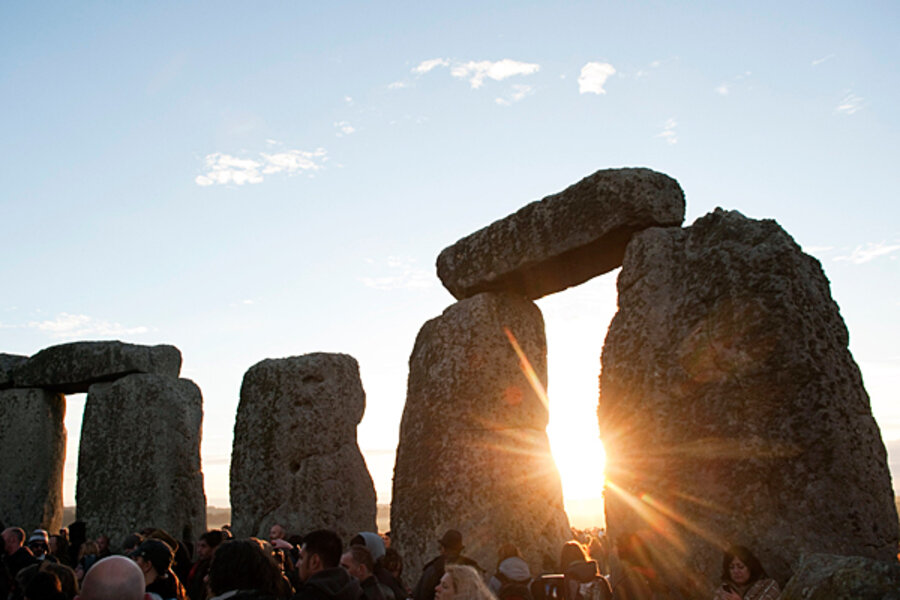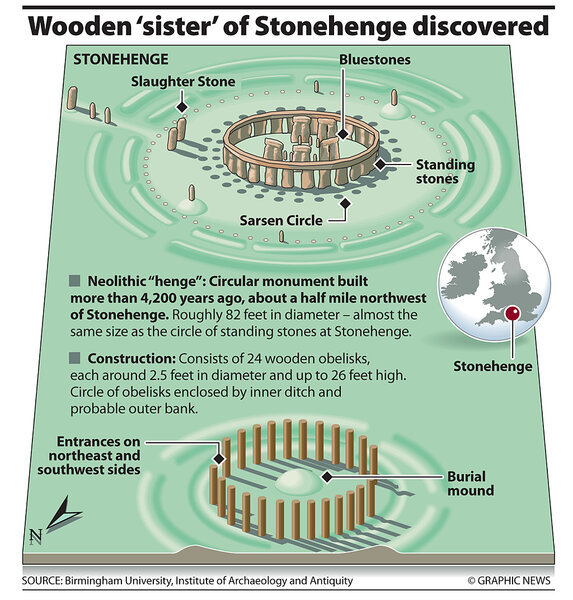Stonehenge timber twin revealed in shovel-less dig
Loading...
| London
“I am a traditional archeologist, I actually love digging,” admits University of Birmingham professor Vince Gaffney. “But that’s not what this is about. This is something different.”
For years, mystery and intrigue has surrounded Stonehenge, the massive Neolithic or Copper age (3,000-2,000 BC) circular stones standing out in the middle of the English countryside where Dr. Gaffney, as part of a team made up of experts from universities across Europe, is digging – well, no, mapping – this summer.
The UNESCO world heritage site lures more than 750,000 curious visitors a year including tens of thousands of druids and sun worshipers who traditionally gather here to every Summer Solstice – but no one has resolved the most basic questions about the site.
IN PICTURES: Summer Solstice at Stonehenge
Was Stonehenge – arguably the world’s most famous prehistoric monument – once a burial ground, a ritual site for human sacrifice, or perhaps an astronomy observatory? And was this a place built by humans, toiling for tens of millions of hours, or were, as some believe, supernatural powers involved in moving stones seemingly impossible to move otherwise?
Now, we might be getting closer to the answers.
Technology brings Stonehenge to life
Without digging up one shovel of earth, or dusting off one rock with a toothbrush, Gaffney and the other members of the Stonehenge Hidden Landscapes Project have uncovered an incredible find – a mere two weeks into a three-year mission to map 5.5 square miles of land around Stonehenge.
The find, discovered 3,000 feet away from the ancient stone structures, is nothing less than a whole new henge – that is, a circular ditch enclosing a ring which could possibly be the remains of another – but this time wooden – monument. The new henge is being dubbed "Timberhenge" or Stonehenge’s “lost twin."
“If this is really a henge, that would indicate this was a much larger ritual site than we once believed,” says Gaffney. Stonehenge did not exist alone… just understanding that contributes to our knowledge of the place.”
As interesting as the henge itself is the way it was uncovered, which is through radar imaging that virtually – but not actually – excavates the terrain, taking millions of measurements which are then massaged by video gaming technology to produce 3D images. The entire discovery remains hidden in the landscape, and nothing is seen by the naked eye.
“What we are doing is mapping out what remains of what used to exist. The structures must once have held posts, for example, and those posts have gone – but the pits that held them remain and we can see them,” explains Gaffney. “You can argue what the shapes mean, but in most cases you are fairly confident you know what you are dealing with.”
Research without 'killing the witnesses'
Essentially the team goes around the land with what looks like big lawnmowers and take a giant x-ray of the area – with the intention of creating an image of the site as it was in 4000 BC. Unlike traditional archeology, proponents of this work argue that the shovel-less excavation does not “kill the witnesses,” which means that future archeologists can come back and re-survey, probably with ever better technology.
The imaging technology has been used by archeologists before, but has become exponentially more effective over the years.
Gaffney, one of the early adopters of the technology, used it in the late 1990s to map an ancient Roman city in Britain – a project hailed as a major achievement at the time. His team collected 2.5 million data points over the course of three years. At Stonehenge this past week, they collected the same amount of data…in a day.
And while some landscapes might not be right for such technology – for example, the magnetic fields of the magnetometers might be effected by electrical cables in urban areas, or the radar images might less reliable in wet environments – it can, and increasingly is, being used at archeological sites around the world.
“This is not a prelude to digging,” concludes Gaffney. “It is its own world.”
IN PICTURES: Summer Solstice at Stonehenge
RELATED STORIES:






